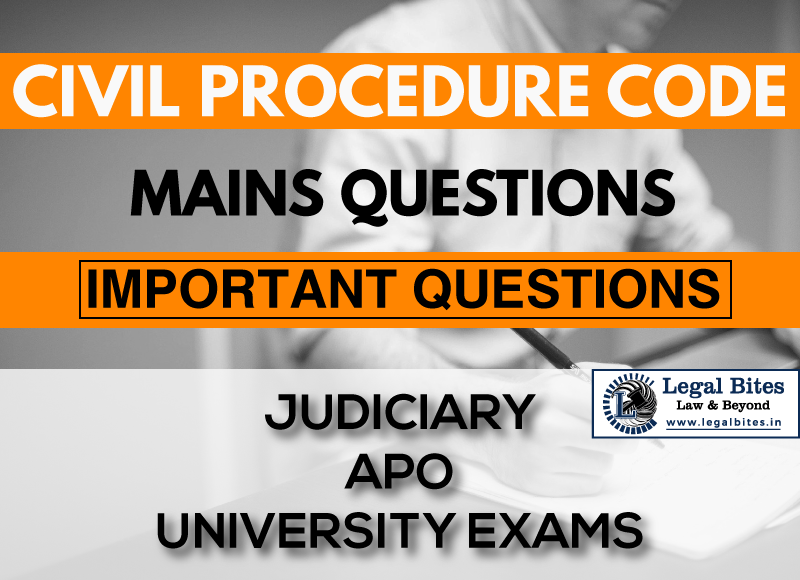What are the grounds for rejection of a plaint? What will be procedure consequent to rejection of plaint?....
Find the answer to the mains question only on Legal Bites.

Question: What are the grounds for rejection of a plaint? What will be procedure consequent to rejection of plaint? Whether rejection of plaint precludes presentation of fresh plaint on same cause of action by plaintiff? [MPJS 2021]Find the answer to the mains question only on Legal Bites. [What are the grounds for rejection of a plaint? What will be procedure consequent to rejection of plaint? Whether rejection of plaint precludes presentation of fresh plaint on same cause of action...
Question: What are the grounds for rejection of a plaint? What will be procedure consequent to rejection of plaint? Whether rejection of plaint precludes presentation of fresh plaint on same cause of action by plaintiff? [MPJS 2021]
Find the answer to the mains question only on Legal Bites. [What are the grounds for rejection of a plaint? What will be procedure consequent to rejection of plaint? Whether rejection of plaint precludes presentation of fresh plaint on same cause of action by plaintiff?]
Answer
The grounds for the rejection of a plaint are listed under Order VII, Rule 11 of the Code of Civil Procedure (CPC), 1908. These grounds include:
- Non-disclosure of cause of action: If the plaint does not disclose a valid cause of action, it can be rejected.
- Relief claimed is undervalued: When the relief claimed in the suit is undervalued, and the plaintiff, despite being directed by the court, fails to correct the valuation within the stipulated time.
- Plaint insufficiently stamped: If the plaint is not properly stamped according to the prescribed court fee and the plaintiff fails to pay the required court fee within the time granted by the court.
- Barred by law: If the suit is barred by any law, for example, the Limitation Act, 1963, or any other statutory provision.
- Lack of jurisdiction: If the court finds that it does not have the jurisdiction to entertain the suit.
- Duplicate suits: If the same cause of action is pending in another court between the same parties (principle of res sub judice).
Procedure Consequent to Rejection of Plaint:
Once the court decides to reject the plaint, the following steps are taken:
- The court issues an order of rejection, specifying the grounds under Order VII, Rule 11 of CPC.
- A rejected plaint does not mean the termination of the legal process as a whole. The rejection merely addresses the technical or formal issues related to the plaint.
- The plaintiff may have the option to file an appeal against the order of rejection.
- Alternatively, the plaintiff may rectify the defects (if possible) and represent the plaint.
Whether Rejection of Plaint Precludes Presentation of a Fresh Plaint on the Same Cause of Action:
Rejection of a plaint does not preclude the plaintiff from presenting a fresh plaint on the same cause of action. Order VII, Rule 13 of the CPC explicitly allows the plaintiff to file a fresh plaint on the same cause of action after curing the defects that led to the rejection of the previous plaint. However, the issues causing the rejection must be resolved, such as correcting the valuation or ensuring proper court fees are paid.
Thus, rejection does not have the same finality as a decree on merits and allows the plaintiff another opportunity to pursue the matter.
Important Mains Questions Series for Judiciary, APO & University Exams
- CPC Mains Questions Series: Important Questions Part – I of X
- CPC Mains Questions Series: Important Questions Part – II of X
- CPC Mains Questions Series: Important Questions Part – III of X
- CPC Mains Questions Series: Important Questions Part – IV of X
- CPC Mains Questions Series: Important Questions Part – V of X
- CPC Mains Questions Series: Important Questions Part – VI of X
- CPC Mains Questions Series: Important Questions Part – VII of X
- CPC Mains Questions Series: Important Questions Part – VIII of X
- CPC Mains Questions Series: Important Questions Part – IX of X
- CPC Mains Questions Series: Important Questions Part – X of X

Mayank Shekhar
Mayank is an alumnus of the prestigious Faculty of Law, Delhi University. Under his leadership, Legal Bites has been researching and developing resources through blogging, educational resources, competitions, and seminars.
